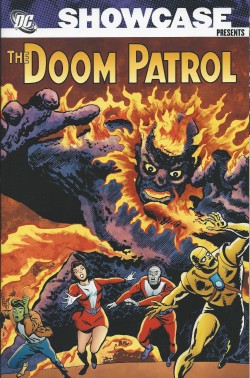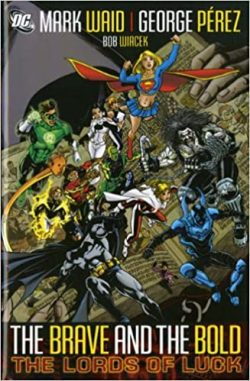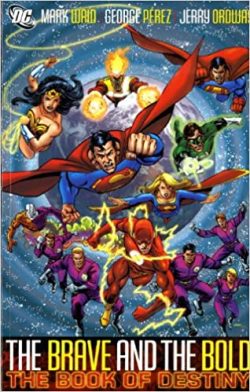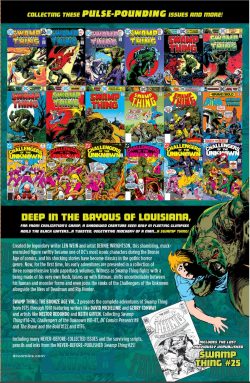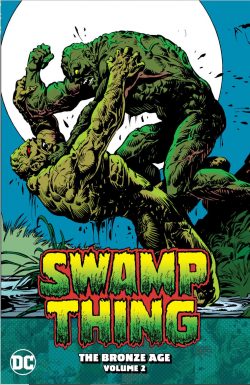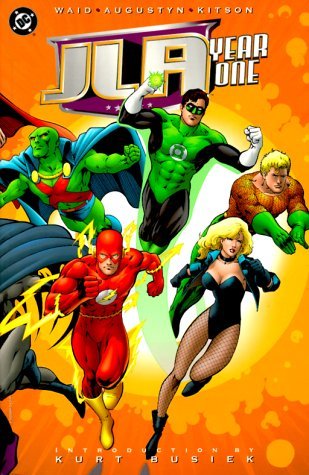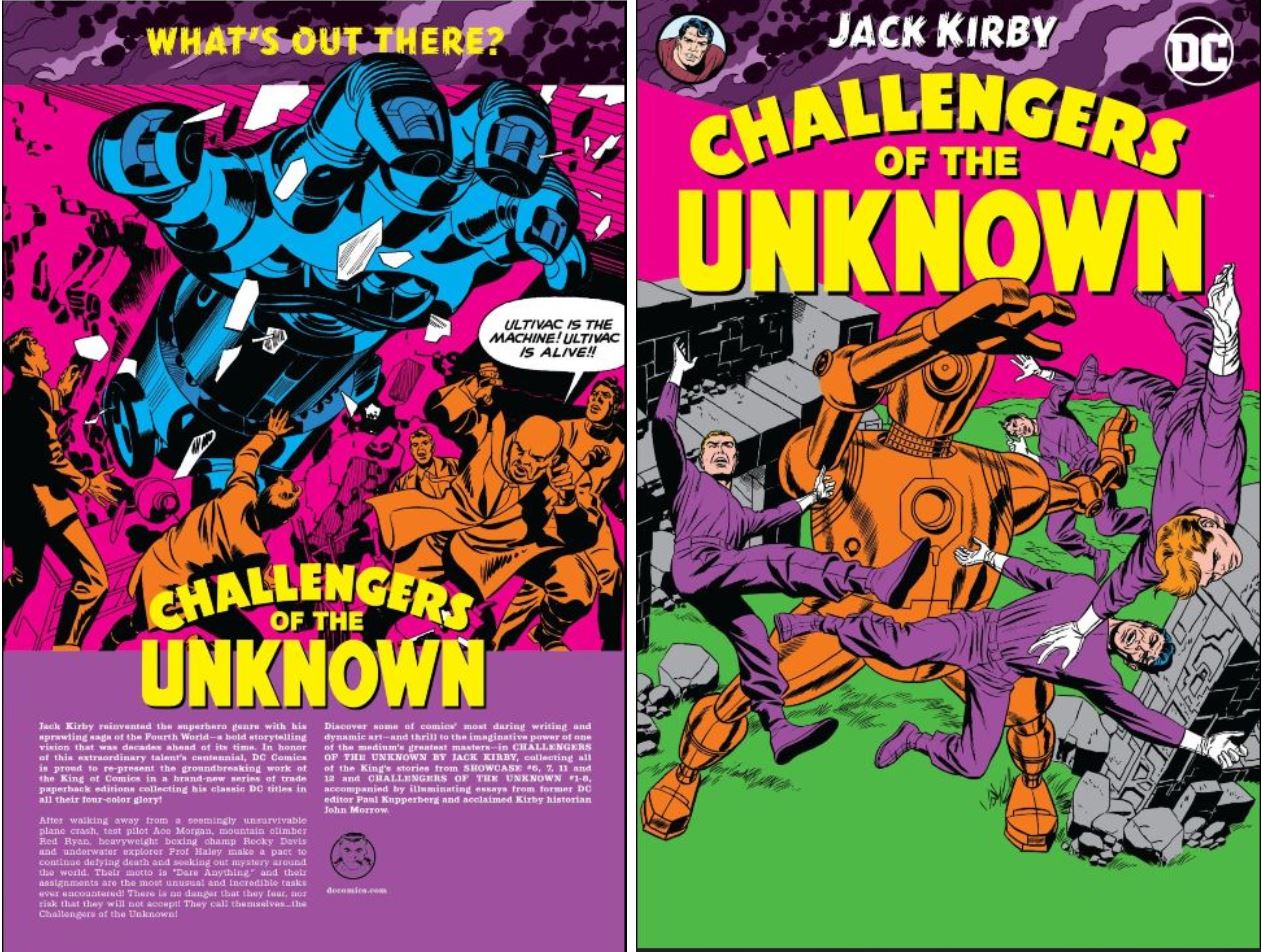
By Jack Kirby, France “Ed” Herron, Dave Wood, Roz Kirby, George Klein, Bruno Premiani, Marvin Stein, Wally Wood & various (DC Comics)
ISBN: 978-1-4012-7719-2 (TPB/Digital edition)
The Challengers of the Unknown were a bridging concept between the fashionably All-American, verifiably human trouble-shooters who monopolised comic books for the majority of the 1950s and the reimagined costumed mystery men who would soon return to take over the industry.
As superheroes began popping up mid-decade, in 1956 came a super-team – the first of the Silver Age – with no powers, the most basic and utilitarian of uniforms and the most dubious of motives… Suicide by Mystery. Nevertheless their launch was arguably the second most important event of the Silver Age
Crucially, they were a huge hit from the get-go, striking a chord that lasted for over a decade before they finally died… only to rise again and yet again. The very idea of them was stirring enough, but their initial execution made their success inevitable.
Jack Kirby was – and remains – the most important single influence in the history of American comics. There are quite rightly millions of words written about what the man has done and meant (such as Paul Kupperberg’s enthusiastic Introduction and John Morrow’s pithy Afterword in this superb compilation), and you should read those if you are at all interested in our medium.
I’m still going to add a few words to that superabundance here: one of his best and most influential projects which, like so many others, he perfectly constructed before moving on, leaving highly competent but never quite as inspired talents to build upon.
When the comics industry suffered a paranoia-induced, witch-hunt-caused collapse in the mid-50’s, Kirby returned briefly to DC Comics to produce tales of suspense and science fiction for the company’s line of mystery anthologies. In a few episodes, he also revitalised Green Arrow (then simply a back-up strip in Adventure Comics) whilst creating the newspaper strip Sky Masters of the Space Force.
At the same time he also re-packaged for Showcase (the try-out title that launched many Silver Age DC mainstays) an off-kilter team concept that had been kicking around in his head since he and long-time collaborator Joe Simon had closed their innovative but ill-timed Prize/Essankay/Mainline Comics ventures.
After years of working for others, Simon & Kirby finally established their own publishing company: producing comics with a much more sophisticated audience in mind. That happened mere months before an industry-wide sales downturn amidst a changing society awash with public hysteria generated by the anti-comic book pogrom spearheaded by US Senator Estes Kefauver and pop psychologist Dr. Frederic Wertham.
Simon quit the business for advertising, but Kirby soldiered on, taking his skills and ideas to a number of safer, more conservative and less experimental companies.
The Challengers were four ordinary mortals; explorers and adventurers who walked away unscathed from a terrible plane crash. Already obviously what we’d now call “adrenaline junkies”, pilot Ace Morgan, diver Prof Haley, acrobat and mountaineer Red Ryan and wrestler Rocky Davis summarily decided that since they were all living on borrowed time anyway, they would dedicate what remained of their lives to testing themselves and fate. They would risk their lives for Knowledge and, naturally, Justice.
The series launched with ‘The Secrets of the Sorcerer’s Box!’ in Showcase #6 (cover-dated January/February 1957 – so it was on spinner-racks and news-stands in time for Christmas 1956). Kirby and scripter Dave Wood, plus inkers Marvin Stein and Jack’s wife Roz, crafted a spectacularly creepy epic wherein the freshly introduced doom-chasers were commissioned by duplicitous magician Morelian to open an ancient container holding otherworldly secrets and powers.
The story roars along with all the tension and wonder of the B-movie thrillers it emulates and Jack’s awesome drawing resonates with power and dynamism, which grew even greater for the sequel: a science fiction drama instigated after an alliance of leftover Nazi technologists and contemporary American criminals unleashes a terrible robotic threat. ‘Ultivac is Loose!’ (Showcase #7, March/April 1957) introduced a necessary standard appendage of the times and the B-movie genre in the form of brave, capable, brilliant and beautiful-when-she-took-her-labcoat-off boffin Dr. June Robbins, who became the no-nonsense, ultra-capable (if unofficial) fifth Challenger at a time when most funnybook females had returned to a subsidiary status in that so-conventional, repressive era.
The uncanny exploits paused for a sales audit and the team didn’t reappear until Showcase #11 (November/December 1957) allowing The Flash and Lois Lane their respective second shots at the big time. When the Challengers returned, it was in alien invasion epic ‘The Day the Earth Blew Up’.
Uniquely engaging comics realist Bruno Premiani (a former associate and employee from Kirby’s Prize Comics days) came aboard to ink a taut doomsday chiller keeping readers on the edge of their seats even today, and in their final Showcase outing (#12, January/February 1958) the Questing Quartet were preparing a move into their own title.
‘The Menace of the Ancient Vials’ was defused by the usual blend of daredevil heroics and inspired ingenuity. The wonderful inking of George Klein adding subtle clarity to a tale of an international criminal who steals ancient weapons that threaten the entire world if misused), but the biggest buzz would come two months later with the first issue of their own magazine.
Written and drawn by Kirby with Stein on inks, Challengers of the Unknown #1 (May 1958) presented two complete stories plus an iconic introductory page that would become almost a signature logo for the team.
‘The Man Who Tampered with Infinity’ pits the heroes against a renegade scientist whose cavalier dabbling unleashes dreadful monsters from the beyond onto our defenceless planet, before the team are actually abducted by aliens in ‘The Human Pets’: forced to win their freedom and a rapid rocket-ship (sphere actually) ride home…
The same team were responsible for both tales in issue #2. ‘The Traitorous Challenger’ is a disturbing monster mystery, with June returning to sabotage a mission in the Australian Outback for the very best of reasons. Then, ‘The Monster Maker’ finds the team seemingly helpless against super-criminal Roc who can conjure and animate solid objects out of his thoughts.
Issue #3 features ‘Secret of the Sorcerer’s Mirror’ with Roz Kirby & Marvin Stein again inking The King’s mesmerising pencils as the fantastic foursome pursue a band of criminals whose magic looking-glass can locate deadly ancient weapons. Undoubtedly, though, the most intriguing tale for fans and historians of the medium is ‘The Menace of the Invincible Challenger’, wherein team strongman Rocky is rocketed into space, only to crash back to Earth with strange, uncanny powers.
For years the obvious similarities of this group – especially this yarn – to the origin of Marvel’s Fantastic Four (#1 cover-dated November 1961) have fuelled fan speculation. In all honesty I simply don’t care. They’re similar but different enough, and equally enjoyable so read both. In fact, read them all.
With #4, the series became visually immaculate as the sheer brilliance of Wally Wood’s inking elevated illustration to unparalleled heights. The scintillant sheen and limpid depth of Woody’s brushwork fostered an abiding authenticity in even the most outrageous of Kirby’s designs and the result is – even now – simply breathtaking.
‘The Wizard of Time’ is a full-length masterpiece that opens with a series of bizarre robberies leading the team to a scientist with a time-machine. By visiting historical oracles, rogue researcher Darius Tiko has divined a path to the far future. When he gets there, he intends to rob it blind, but the Challengers find a way to follow and foil him…
‘The Riddle of the Star-Stone’ (#5) is a full-length contemporary thriller, wherein an archaeologist’s assistant uncovers an alien tablet bestowing various super-powers when different gems are inserted into it. The exotic locales and non-stop action are intoxicating, but Kirby’s solid characterisation and ingenious writing are what make this such a compelling read.
Scripter Dave Wood returned for #6’s first story. ‘Captives of the Space Circus’ sees the team shanghaied from Earth to perform in an interplanetary travelling carnival, before the evil ringmaster is promptly outfoxed and they return for France “Ed” Herron’s mystic saga ‘The Sorceress of Forbidden Valley’. Here, June becomes an amnesiac puppet in a power struggle between a fugitive gangster and a ruthless feudal potentate.
Issue #7 offers another daring double-feature: both scripted by Herron. First comes relatively straightforward alien-safari saga ‘The Beasts from Planet 9’, but it’s followed by a much more intriguing yarn. On the ‘Isle of No Return’, the “Challs” face a super-scientific bandit whose shrinking ray leaves them all mouse-sized….
Concluding Kirby-crafted issue #8 (July 1959) delivers a magnificent finale to a superb run as The King & Wally Wood go out in stunning style with a brace of gripping thrillers – both of which introduce menaces who would return to bedevil the team in future exploits.
Dave Wood, Kirby and the unrelated Wally Wood reveal ‘The Man Who Stole the Future’: introducing evil mastermind Drabny who steals mystic artefacts and conquers a small nation before the team dethrone him. However, although this is a tale of spectacular battles and uncharacteristic, if welcome, comedy, the real gem here is space opera tour-de-force ‘Prisoners of the Robot Planet!’ Written by Kirby (probably with Herron), it sees the human troubleshooters petitioned by a desperate alien, travelling to his distant world to liberate the organic population from bondage to their own robotic servants These have risen in revolt under the command of the fearsome autonomous automaton, Kra in a clear example of fiction foreshadowing fact. Do you know what your AIs do while you’re reading old comics…?
These are classic adventures, told in a classical manner. Kirby developed a brilliantly feasible concept with which to work and heroically archetypical characters. He then tapped into an astounding blend of genres to display their talents and courage in unforgettable exploits that informed and affected every team comic that followed – and absolutely informed his successive landmarks with Stan Lee.
But then Jack was gone…
The Challengers followed the Kirby model until cancellation in 1970, but due to a dispute with Editor Jack Schiff the writer/artist resigned at the height of his powers. The Kirby magic was impossible to match, but as with all The King’s creations, every element was in place for the successors to run with. Challengers of the Unknown #9 (September 1959) saw an increase in those fantasy elements favoured by Schiff, and perhaps an easing of the interpersonal tensions that marked previous issues (Comics Historians take another note: the Challs were bitching, bickering and barking at each other years before Marvel’s Cosmic Quartet ever boarded their fateful rocket-ship).
But that’s meat for another book and review…
Challengers of the Unknown is groundbreaking, wonderful and utterly timeless: sheer escapist thrills no fan of the medium should miss and perfect adventurers in the ideal setting of not-so-long-ago in a simpler, better galaxy than ours.
© 1957, 1958, 1959, 2003, 2017 DC Comics. All Rights Reserved

